| Columns Retired Columns & Blogs |
Simaudio Moon Evolution 700i integrated amplifier Measurements
Sidebar 3: Measurements
I carried out a complete set of tests on the Simaudio Moon 700i, using Stereophile's loan sample of the top-of-the-line Audio Precision SYS2722 system (see the January 2008 "As We See It" and www.ap.com). Before doing the testing, I ran the Simaudio at one-third its rated power for 60 minutes, which thermally is the worst case for an amplifier with a class-A/B output stage. At the end of that period, the chassis was warm, at 40°C (104°F), according my infrared thermometer, but the side-mounted heatsinks were just too hot to keep my hand on, at 63°C (145°F).
The maximum voltage gain into 8 ohms was 36.8dB for the balanced and unbalanced inputs, and both preserved absolute polarity (ie, were non-inverting), which means the XLR jacks are wired with pin 2 hot. The maximum gain from the unbalanced preamplifier output was 4.5dB for the unbalanced inputs and 5.5dB for the balanced inputs, sourced from an impedance of 50 ohms at all frequencies. This output was also non-inverting. The unbalanced input impedance at low and midrange frequencies was a little lower than the specified 23.7k ohms, at 18.5k ohms. However, it dropped at the top of the audioband to 5k ohms, which might make some tubed source components with a high source impedance sound a little mellow. The balanced input's impedance was 31k ohms across most of the audioband, dropping to 13k ohms at 20kHz.
The output impedance (including 6' of speaker cable) was a low 0.07 ohm at 20Hz and 1kHz, rising slightly to 0.11 ohm at 20kHz. As a result, the modification of the amplifier's frequency response due to the interaction between this impedance and that of our standard simulated loudspeaker was less than ±0.1dB (fig.1, gray trace). The amplifier's ultrasonic output into 8 ohms dropped by 3dB at 90kHz (fig.1, blue and red traces), and by 3dB at 55kHz into 2 ohms (green trace), this fairly wide bandwidth resulting in a good reproduction of a 10kHz squarewave (fig.2). The fig.1 traces were taken with the volume control at its maximum setting of "80"; repeating the measurement with the control set to "43.2" resulted in an 8 ohm response that was identical to that in fig.1. The amplifier's bandwidth is thus not affected by the volume-control setting. The control operated with accurate 0.1dB steps above "30," and with 1.0dB steps below that level.
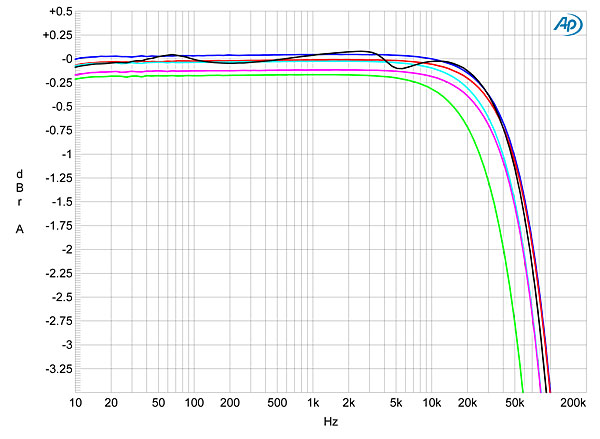
Fig.1 Simaudio Moon Evolution 700i, frequency response at 2.83V into: simulated loudspeaker load (gray), 8 ohms (blue), 4 ohms (magenta), 2 ohms (green). (0.25dB/vertical div.)
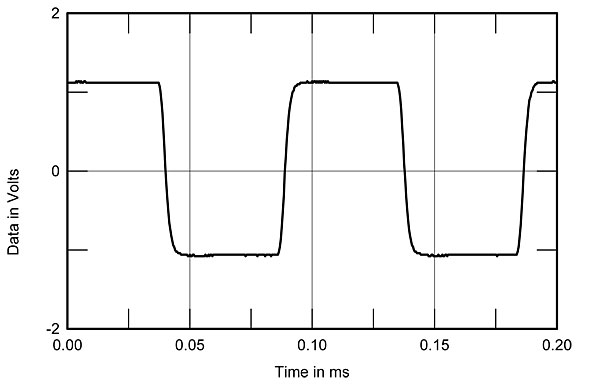
Fig.2 Simaudio Moon Evolution 700i, small-signal 10kHz squarewave into 8 ohms.
Channel separation was excellent, at >110dB in both directions below 1kHz and still 100dB at 20kHz (not shown). The unweighted, wideband signal/noise ratio, measured with the input shorted but the volume control set to its maximum, was good rather than great, at 71.5dB ref. 2.83V into 8 ohms. Restricting the measurement bandwidth improved this figure to 78.5dB; switching an A-weighting filter in-circuit gave 81dB. These figures were for the right channel; the left channel was very slightly noisier.
Fig.3 plots the THD+noise percentage in the Simaudio's output against power into 8, 4, and 2 ohms. The downward slope of the traces below a few tens of watts suggests that the measured percentage is dominated by noise at low powers; the gentle rise in the percentage with increasing power once the actual distortion appears suggests that only a modest amount of global negative feedback is used. The amplifier exceeds its specified output power of 175Wpc (22.43dBW) into 8 ohms, delivering 190Wpc (22.8dBW) at clipping (defined as 1% THD+N), but with both channels driven it falls slightly short of the specified 350Wpc into 4 ohms, clipping at 305Wpc (21.8dBW). Running at this power level for more a couple of seconds blew the 6A rear-panel fuse. With one channel driven, the Moon 700i clipped at 590W into 2 ohms (21.7dBW).
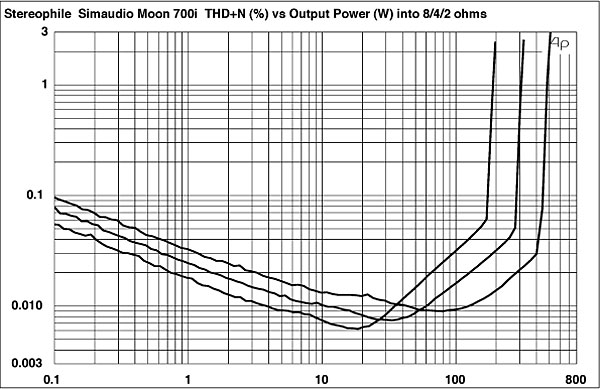
Fig.3 Simaudio Moon Evolution 700i, distortion (%) vs 1kHz continuous output power into (from bottom to top at 10W): 8, 4, 2 ohms.
I plotted how the THD+N percentage varied with frequency (fig.4) at a high enough output voltage, 20V, to be sure I was measuring distortion rather than noise. The right channel (red and magenta traces) is not quite as linear as the left. More important, while the THD rises only a little when the load impedance is halved, there is a considerably greater rise in the top two audio octaves. This is presumably due to the circuit's relatively limited open-loop bandwidth not allowing the negative-feedback loop to operate with full efficiency above 3kHz or so. Fortunately, this behavior is mitigated by the low level of distortion and the fact that it consists primarily of the subjectively innocuous second and third harmonics (figs. 5 and 6). Fig.6 also reveals that, even at very high power, the power-supply–related components at 60 and 120Hz are both well suppressed.
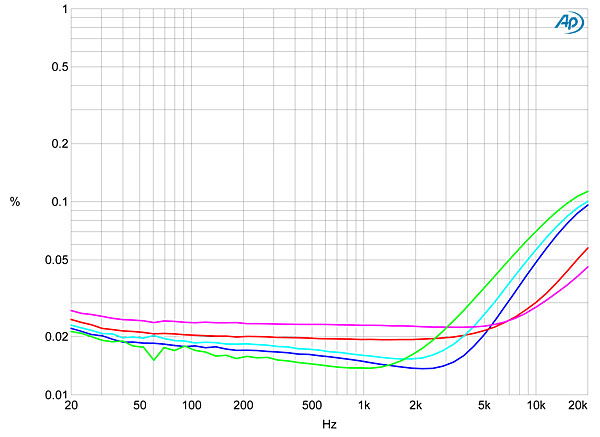
Fig.4 Simaudio Moon Evolution 700i, THD+N (%) vs frequency at 20V into: 8 ohms (left channel blue, right red), 4 ohms (left cyan, right magenta), 2 ohms (green).
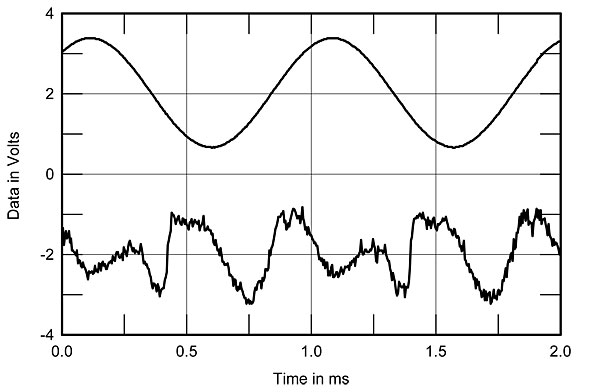
Fig.5 Simaudio Moon Evolution 700i, 1kHz waveform at 12W into 8 ohms (top), 0.0075% THD+N; distortion and noise waveform with fundamental notched out (bottom, not to scale).
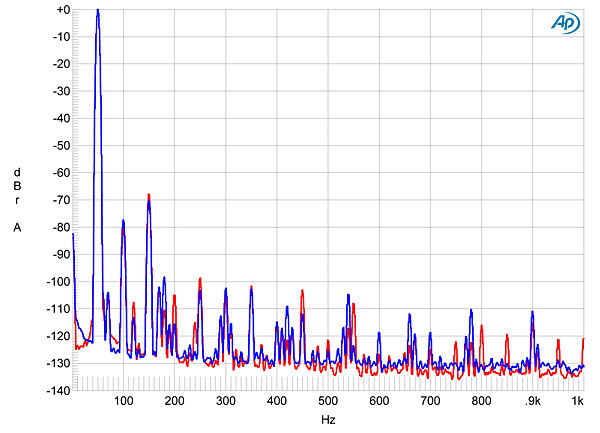
Fig.6 Simaudio Moon Evolution 700i, spectrum of 50Hz sinewave, DC–1kHz, at 200Wpc into 4 ohms (linear frequency scale).
Finally, the circuit's decreasing linearity in the top octaves results in a regular series of intermodulation products when the 700i is asked to drive an equal mix of 19 and 20kHz tones at a level just below visible waveform clipping on an oscilloscope (fig.7). Even at this high power, however, the lowest-order products, at 1, 18, and 21kHz, all lie at –74dB (0.02%), with the higher-order products lower in level. This behavior was not appreciably different into lower impedances.
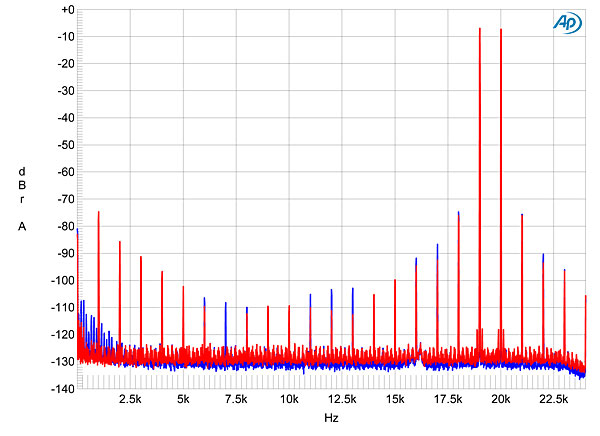
Fig.7 Simaudio Moon Evolution 700i, HF intermodulation spectrum, DC–24kHz, 19+20kHz at 100W peak into 8 ohms (linear frequency scale).
Other than its behavior with the high-frequency intermodulation test, the Simaudio Moon 700i offered respectable measured performance.—John Atkinson
- Log in or register to post comments




































